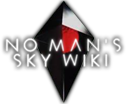| The subject of this article is from the Echoes update.
The information from this article is up-to-date as of 13 February, 2024. |
The information from this article is up-to-date as of 13 February, 2024.
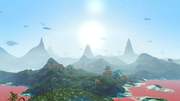
Terrain Archetype is a landscape page.
Summary[ | ]
The topography and geology of planets in No Man's Sky may look diverse, but after close inspection of several planets and moons, 10 distinct terrain archetypes are observed. Every planet and moon has only one terrain archetype.
Since Origins, newly birthed planets will have the new, more mountainous terrain generation. 1-2 new celestial bodies can be born per Star system and they are always the farthest from the Space station. Systems that already have six celestial bodies before the Origins update will not have planets with the new terrain generation. Planets with no water have a consistently mountainous terrain all throughout. However, in planets with oceans, terrain closer to the coast is flatter or resembling older pre-Origins planets. As one goes farther inland, it gradually becomes more and more mountainous.
Basic Types[ | ]
Floating Islands[ | ]
This terrain archetype has large floating islands. Some of them follow the shape of the terrain directly below it, as if they're cut from the ground. In planets with oceans, one can see various regularly-shaped islands that are almost completely flat. They partially submerged floating islands with the top exposed. Compared to the Hills terrain archetype, the floating islands here have flora while the other is barren.
Huge Caves[ | ]
This terrain type has enormous caves that can easily fit a large hauler-type starship inside. In planets with oceans, huge and magnificent underwater overhangs and cave structures can be found.
Bottomless Pits[ | ]
Mostly flat terrain, with occasional mountains, and extremely deep and foggy pits with almost completely vertical walls.
Spires[ | ]
This type has rougher terrain and super-tall mountain spires, occasionally reaching the cloud layer.
Monoliths[ | ]
This terrain archetype is unique for its many rock formations of different shapes and sizes on relatively smooth rolling plains. However, a planet with this terrain archetype can have only one particular rock formation. Examples include large squares, pyramids and wedding rings. The massive ring-like structures in some mega-exotic planets and moons don't count.
Extreme Mountains[ | ]
Advanced Types[ | ]
Craters[ | ]
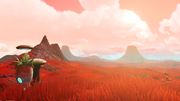
Tall mountains are one of the features.
This terrain archetype is marked by tall, isolated mountains which can occasionally merge together, forming a wall. There are numerous craters scattered all over the surface. In some planets and moons, the craters are bulges instead. In planets with oceans, the craters can occasionally form perfectly circular pools of water.
Alternative names: Buttes
Flatlands[ | ]
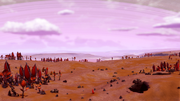
If a planet seems rather flat like this one, there are massive caves hidden somewhere.
This terrain archetype has vast expanses of plains and flatlands. It also has enormous caves that can easily fit a large hauler-type starship inside. In planets with oceans, huge and magnificent underwater overhangs and cave structures can be found.
Alternative names:
Flat Tops (Mountains)[ | ]
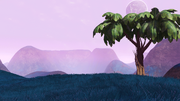
Narrow and winding valleys separate the super-tall flat top mountains here.
The more mountainous version features narrow and winding valleys, deep ravines and mountains that reach cloud height with a more or less smooth flat top.
Alternative names:
Uplands (Mountains)[ | ]
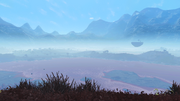
A wide open plain and mountains in the distance.
The more mountainous version has a mix of tall mountains and flat plains in-between. The hills and mountains are bumpy but somewhat smooth, forming narrow passes and occasionally, deep pits and ravines. Relatively large plateaus can be found at higher elevations. Between the mountains are vast expanses of mostly flat plains.
Alternative names:
Hills[ | ]
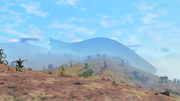
Hilly terrain and large anvil-shaped land formations are common.
This terrain archetype is characterized by rolling hills and large, anvil-shaped land formations varying in size. Occasionally, the lower half of the anvil can be missing, resulting in floating islands. However, the main difference between the floating islands here and the Floating Islands archetype is a lack of flora at the top.
Alternative names: Overhangs
Overhangs (Mountains)[ | ]
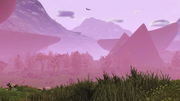
The mountains here can easily reach cloud height.
The more mountainous version features rugged and imposing mountain ranges that shoot into the clouds. Valleys of varying size form in-between them. The terrain can get a bit too rough and rugged to form plateaus for the most part, but the tallest mountains have them at the peak. The large rock formations have grown even larger.
Alternative names:
Honeycomb[ | ]
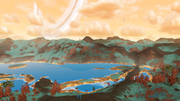
The terrain is relatively mountainous. There are stretches of rocky surfaces that can be seen dividing areas.
This terrain archetype has rock formations that seem to snake through and interweave with each other, dividing the land into various areas. Occasionally, some of the areas result in basins and valleys. When viewed from above, it vaguely resembles a honeycomb or ore veins. This, the Mountains and Stoneroot terrain archetypes can be difficult to distinguish from one another.
Alternative names: Veins
Rugged Mountains (Mountains)[ | ]
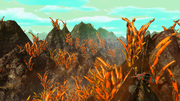
Do I dare traverse this on foot or on exocraft?
The more mountainous version features perilously treacherous and unforgiving terrain, thanks to its razor-sharp peaks, ridiculously narrow passes, steep drops and seemingly bottomless pits in-between. Traversing this terrain archetype is exceptionally difficult and highly dangerous, whether by starship, exocraft or on foot. Tread carefully.
Alternative names: Rugged Mountains
Mesa[ | ]
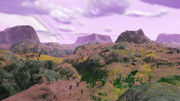
Large tabletop mountains and deep depressions dominate this terrain archetype.
The Pits Terrain archetype is characterized by large tabletop mountains and deep depressions that can extend for quite a distance. If the planet has water, the depressions can form large and deep lakes. Extreme weather planets can give an impression of bottomless pits during storms.
Alternative names: Pits
Chasms (Mountains)[ | ]
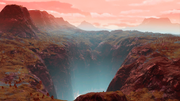
Seemingly bottomless pits can be found here.
The more mountainous version isn't too obvious at first glance. On closer inspection though, one will notice the significantly deeper and bigger ravines, pits and fissures compared to the normal version. The terrain is a bit rougher and the tabletop mountains seem to be rougher and higher in elevation.
Alternative names:
Rolling Mountains (Mountains)[ | ]
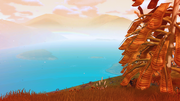
Tall mountains with valleys and plateaus can be found further inland.
The more mountainous version features really tall and relatively smooth mountain ranges, interspersed with valleys and high plateaus. While they don't go as high as other mountainous terrain archetypes, it is still quite a breathtaking sight nonetheless.
Alternative names:
Mountains[ | ]
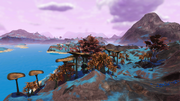
Rugged mountains, mountain islands and winding rivers can be seen here.
This terrain archetype is characterized by rough and rugged mountains which can be tricky to traverse. If a planet has oceans, it can result in many mountain islands and winding rivers further inland.
Alternative names:
Tall Mountains (Mountains)[ | ]
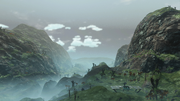
Rough terrain and rugged mountains are commonplace.
The more mountainous version simply has higher and wider peaks and significantly rougher terrain.
Alternative names:
Rock Pillars[ | ]
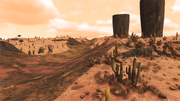
Tall rock pillars and riverbeds are some of the features of the Rock Pillars archetype.
This terrain archetype has vast plains dotted by tall rock pillars. Some of the pillars are large enough to have a hollow interior while others resemble a giant avocado. Sometimes, one can see a dry riverbed. On planets with water, the riverbeds can have water, resulting in rivers or seemingly artificial canals.
Alternative names:
Rolling Hills (Mountains)[ | ]
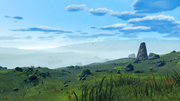
Rolling hills that seem to just go on and on define the more mountainous version.
The more mountainous version features smooth, rolling hills that seem to just go on and on. Occasionally, they can get rather high but not high enough to reach cloud level.
Alternative names:
Stoneroot[ | ]
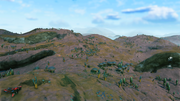
One can see barrier-like land formations winding and snaking through the land.
This terrain archetype is mountainous, ornamented by tall and winding barrier-like land formations.
Alternative names: Roots
